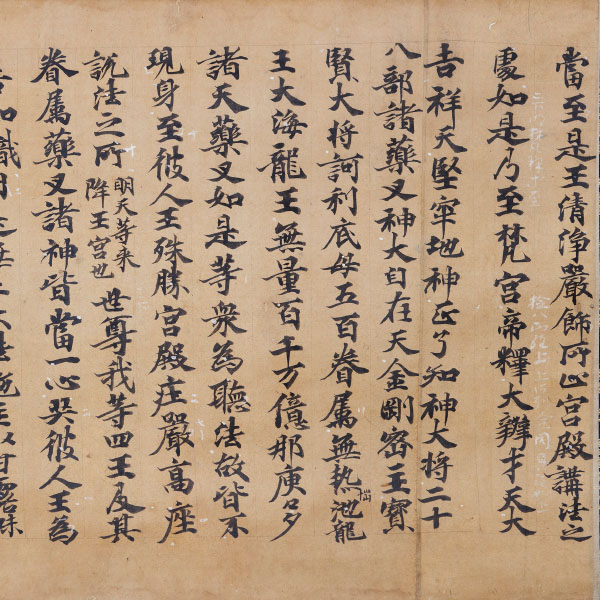
・年代:平安時代前期(9世紀)
・法量:縦27.3㎝ 横51.6㎝
The Commentary on the Golden Light Sutra(Iimuro-giri)
Era: Early Heian period (9th century)
Dimensions: Height 27.3 cm, Width 51.6 cm
「金光明最勝王経注釈」は、東大寺の明一(728~798)が撰した文献で、鎮護国家の力があるとして重んじられた金光明最勝王経の解説書です。本品はこれを平安時代前期に書写したもので、本文を墨字で書写した上、白字で読みや簡単な解説を書き込んでいます。本経はもと比叡山横川の飯室別所に長く伝えられたところから、飯室切の名で知られています。本品は長い歴史の中で、三筆の一人である嵯峨天皇が書写したものに、空海が白字を付したと伝えられ、珍重されてきました。残念ながら現在、この説は否定されていますが、本経の大振りで力強い筆跡は平安時代前期を代表する書として高く評価されています。
フリガナとして付された白字は漢字の一部を崩して用いたものであり、日本固有の仮名文字が成立する過程を示すものとして、国語学上極めて貴重な資料となっています。
"The Commentary on the Golden Light Sutra" is a document compiled by Myoichi of Todai-ji (728-798), which is a commentary on the Golden Light Sutra, revered for its power to protect the nation. This particular manuscript was transcribed in the early Heian period, with the main text written in black ink and readings and simple explanations added in white ink. Originally, this sutra was long transmitted at Iimuro Betsusho in Yokogawa, Mount Hiei, and is known by the name "Iimuro-giri."
Throughout its long history, it was believed that Emperor Saga, one of the three great calligraphers, transcribed the main text, and Kukai added the white ink annotations. Although this theory is now denied, the bold and powerful calligraphy of this sutra is highly regarded as representative of the early Heian period.
The white ink annotations, used as furigana, are derived from simplified parts of kanji characters, making this manuscript an extremely valuable resource in the study of the development of Japan's unique kana script.
